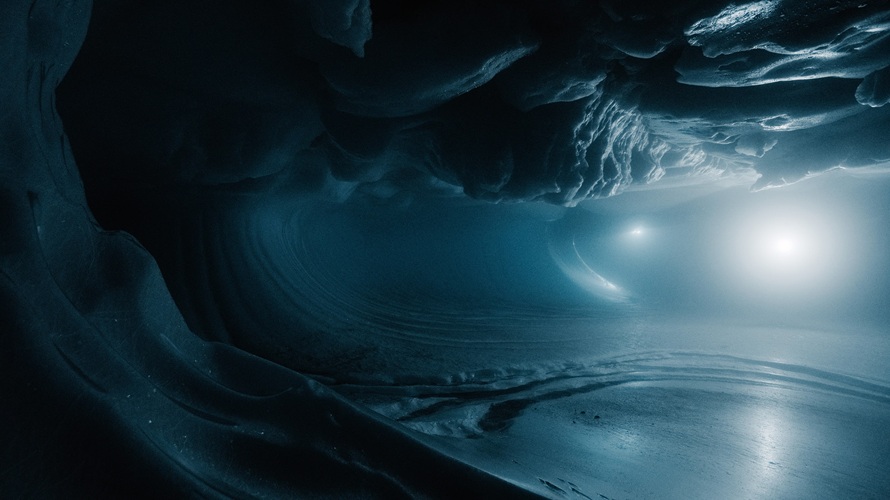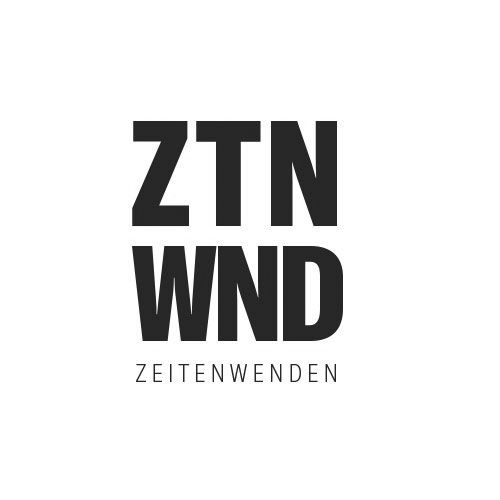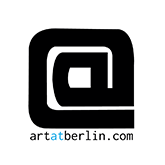From 11 June to 2 November 2025, the French-Swiss artist Julian Charrièere is presenting an extensive solo exhibition at Museum Tinguely with photographs, sculptures, installations and new video works that explore the relationship to the earth as a world of water, an element that covers most of our planet in the form of seas, lakes and ice.
Image above: Albedo (Video Still), Julian Charrière, 2025, ProLitteris, Zürich; Copyright the artist.
The exhibition Midnight Zone, which extends over three floors at Museum Tinguely, centres on submarine ecosystems – from the locally present and influential Rhine to distant oceans – which reveal the complexity of water as an element that is significantly affected by human activity. The solo exhibition examines the cycle of water and its materiality, its depths and the political aspects associated with it, its everyday and sacred dimensions. A kaleidoscope unfolds before visitors, inviting them to immerse themselves deeply.
“Water is not a landscape – it is the prerequisite for all life, the first outer skin of the Earth, the medium of our becoming.”
Julian Charrière
In the exhibition Midnight Zone, Julian Charrière invites museum visitors to think and feel with water – as a mediator of moods and memories, movement and kinship. Between diving into the deep sea and the suspended state of the cryosphere, the exhibition unfolds like an immersive reflection on fluid worlds – here, the sea appears not as a surface, but as a substance in which boundaries dissolve. For the artist, the exhibition is not just an accessible space, but a world into which visitors can immerse themselves and move around in order to experience the pressure, the depths and the dreams associated with them.
The exhibition brings together a series of fundamental works – earlier works as well as important new commissions that illustrate Charrière’s longstanding exploration of ecological border areas. The focus is not on water as a motif, but as a medium – as the element in which stories are deposited, crises develop, forms and shapes change their state. The title refers to the midnight zone of the deep sea, where the sunlight fades and visibility disappears.
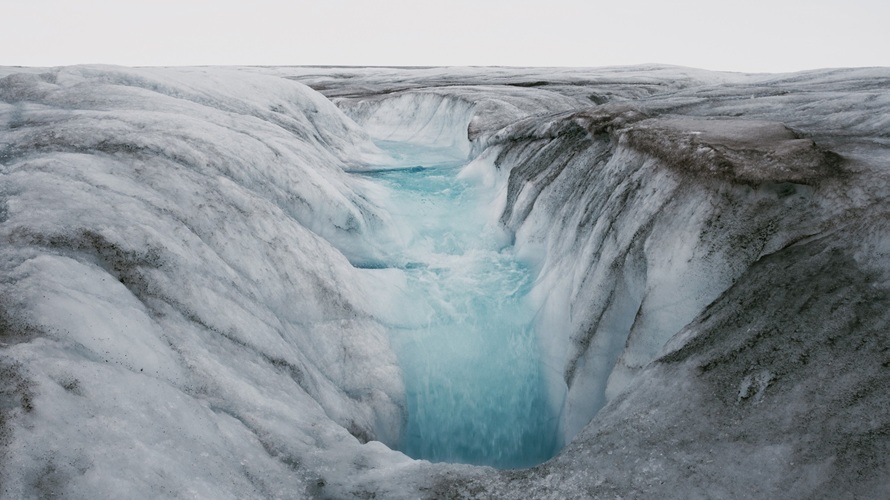
In the video of the same name, Midnight Zone (2025), a Fresnel lens – the lens of a lighthouse that provides orientation from a distance – is lowered upside down into the abyss of the sea. The dive, documented by the camera of a remote-controlled deep-sea vehicle, is to be understood both literally and metaphysically. It is a journey into a space that defies orientation, where polymetallic nodules – objects of industrial desire – rest in the midst of ancient ecosystems. The light here does not reveal, it refracts. The work transports the viewer into a dreamlike state of suspension and at the same time illuminates the blind spots in our quest for progress.
The video work Albedo (2025), which was filmed under the surface of the Arctic Ocean between icebergs, offers a completely different perspective. Here, the audience follows the water, whose aggregate state changes between solid, liquid and gaseous – a choreography in real time. The film does not portray the melting of the ice as a catastrophe, but rather refuses any lofty perspective and opens up an understanding of the constant movement of water, its climatic significance and human failings. He presents the sea as a kind of world of thought: boundless, destabilising and impossible to tame. The camera hovers, frames, lets go. There are no fixed perspectives – only drift, suspension, dispersion.
These two film works form the anchor of the exhibition, which unfolds like a water cycle and moves between different materialities, spatial perceptions and emotional states. In the city of Basel and against the backdrop of its location on the water, the show deals with the political and infrastructural presence of water. As a link between glaciers and oceans, the Rhine flows tirelessly alongside the museum – both a trade route and a climatically sensitive artery. Sound also runs through the exhibition – subtly and insistently – like an underwater current, creating a synaesthetic experience that invites visitors inside not only to look, but also to listen, to feel and to tune into a different kind of perception: one that seeks to come closer to resting, floating, being underwater.
Charrière’s multidisciplinary work, which spans film, sculpture, photography and installation, is characterised by immersive projects based on field research in ecologically and symbolically charged places – glaciers, volcanoes, nuclear test sites and deep-sea ecosystems. Through his in-depth engagement with these fragile environments, he explores how human activity inscribes itself into the structure of the planet and subtly alters its surfaces, atmospheres and futures. His works combine scientific observation with speculative poetry, focussing on landscapes as physical processes, repositories of memories and associative spaces of cultural imagination. Rather than depicting environmental crises one-to-one, Charrière creates spaces that evoke both wonder and concern for the future of the planet, making the contradictions and tensions of our current situation directly tangible. In his works, he examines the colonial and extractivist legacy inscribed in research activities, landscape representations and the technologies of seeing.
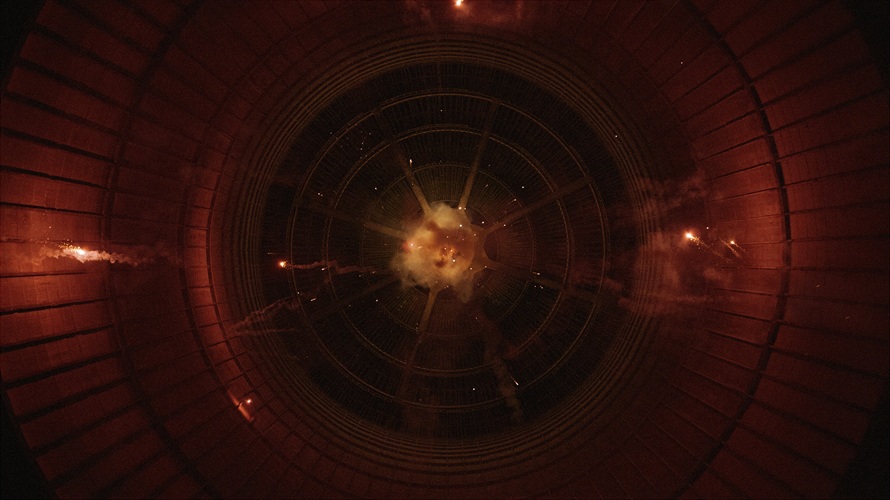
In the Midnight Zone exhibition, the works convey knowledge in a sensory way. Here, water is not seen as a stage for human drama, but as a protagonist, an archive and a mirror, a diluting solvent and a measurable medium that holds the memory of tomorrow’s glaciers and minerals. Charrière wants to show how water connects our breath to the biosphere and how it reveals the fragility of a world shaped by evaporation, melting and sedimentation. The exhibition reminds visitors that the sea is not the opposite of land, but its prerequisite. Humans are suspended in its currents – biologically, historically and imaginatively. In the works shown in Basel, Julian Charrière does not want to show us the sea. Rather, he wants to let it speak, pulsate and breathe through an elemental choreography of sound and image. The result is not representation, but resonance: a state of atmospheric intimacy, an invitation to understand its currents.
About Julian Charrière
Julian Charrière (born 1987) is a Swiss-French artist living in Berlin who explores the cultural and environmental history embedded in natural landscapes. In his works, he contrasts geological and human time horizons, revealing the slow and often invisible forces that shape and transform landscapes and terrain formations as well as our historical perceptions. Charrière studied at the Berlin University of the Arts (UdK) and at Olafur Eliasson’s Berlin Institute for Spatial Experiments.
His artworks have been exhibited worldwide, including solo exhibitions at the ARKEN Museum of Contemporary Art, Denmark (2024), the Palais de Tokyo, France (2024), the San Francisco Museum of Modern Art, USA (2022/23), the Dallas Museum of Art, USA (2021), the Langen Foundation, Germany (2022/23), the Museo d’Arte Moderna di Bologna (MAMbo), Italy (2019), the Aargauer Kunsthaus, Switzerland (2020), the Berlinische Galerie, Germany (2018/19) and the Parasol Unit Foundation for Contemporary Art, England (2016).
His work has also been exhibited at the Centre Pompidou, France (2021/22), in the Parcours section of Art Basel (2023), at the Fondation Beyeler, Switzerland (2024), at the Mori Art Museum, Japan (2023/24), and repeatedly at the Venice Biennale. Julian Charrière is the first recipient of the Eric and Wendy Schmidt Environment and Art Prize, awarded in 2024 by the Museum of Contemporary Art (MOCA) in Los Angeles.
WHEN?
Exhibition dates: Wednesday, 11. June – Sunday, 02. November 2025
WHERE?
Museum Tinguely
Paul Sacher- Anlage 1
4002 Basel
Switzerland


